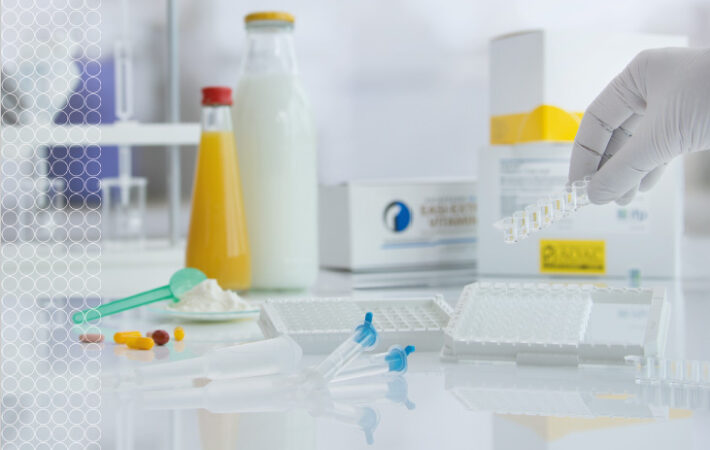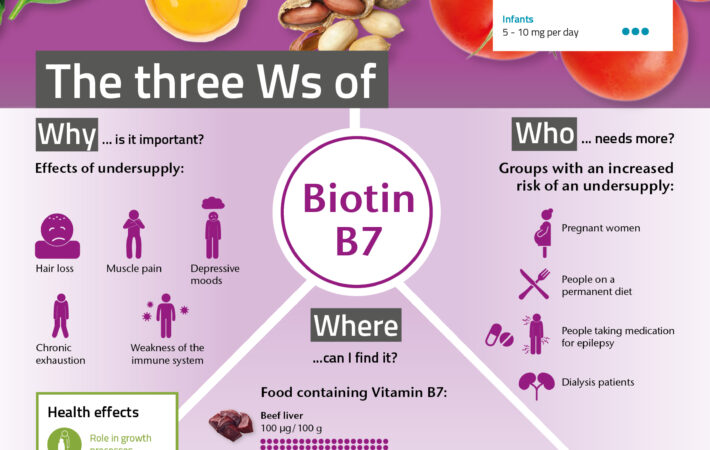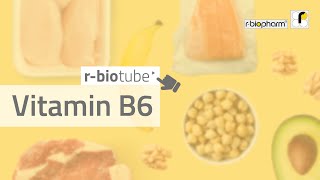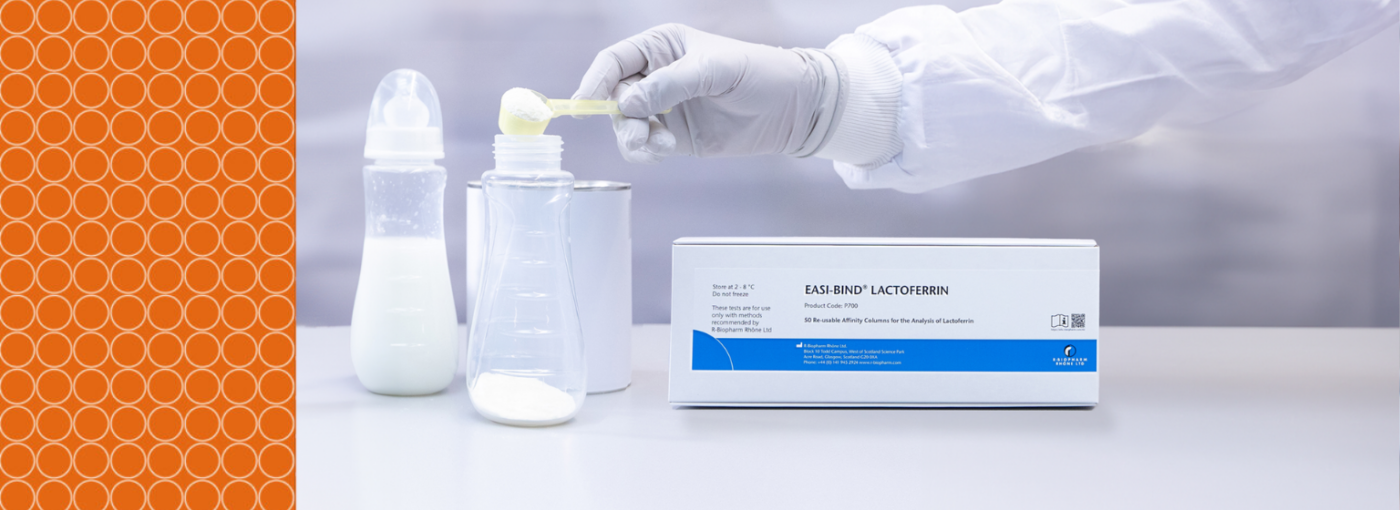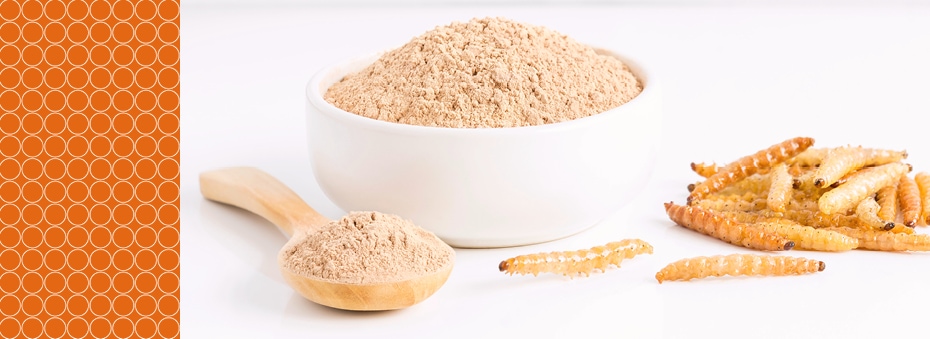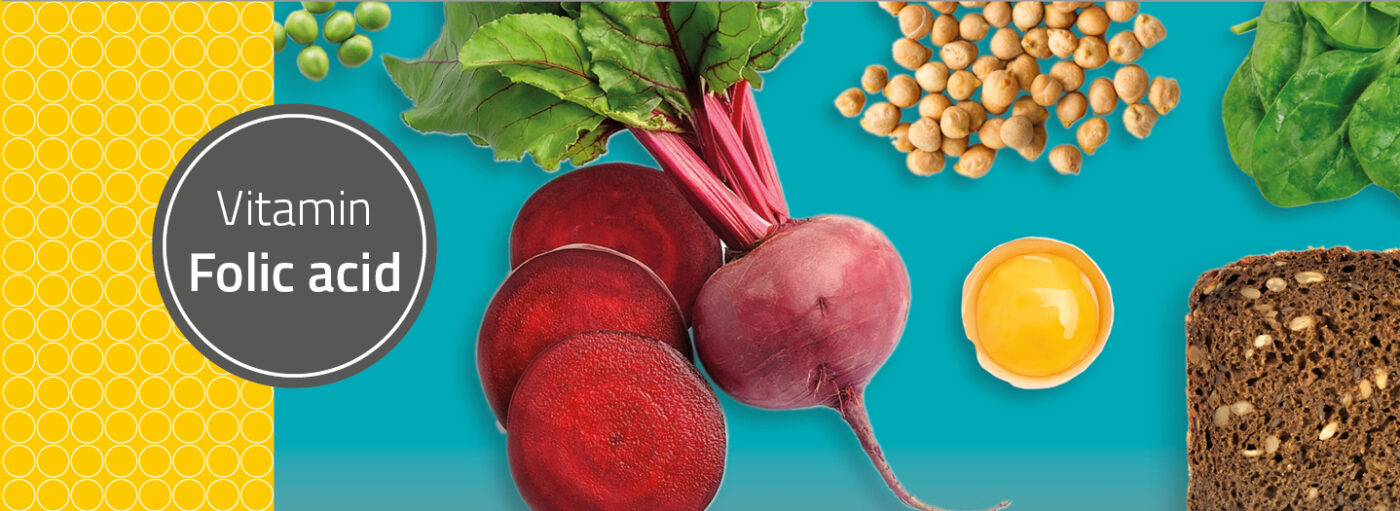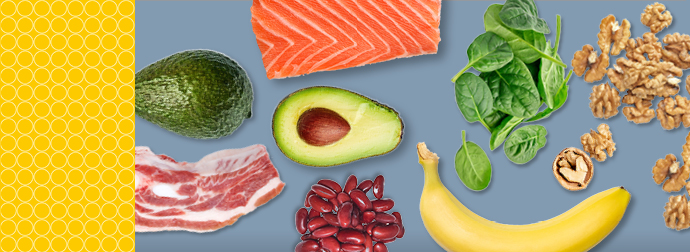
Vitamins
Test systems for the determination of vitamin contents in food
Vitamins
A lot of foods are fortified with vitamins, for example juices, dairy products, baby food, cereals, sweets, tablets and vitamin mixtures. To measure the exact concentration of vitamins in food, R-Biopharm offers a wide portfolio of test systems.
Test methods to analyze the vitamin content
According to the laboratory equipment (whether an HPLC device or a microwell photometer is available), detection can be carried out with the instrumental method (HPLC, LC-MS/MS) in combination with immune affinity columns (EASI-EXTRACT®) for pre-purification and concentration of the samples. Depending on the sample preparation, the added vitamin content or the total vitamin content can be determined. If a microwell photometer is available, there is the option of either an ELISA (RIDASCREEN®) or a microbiological test system (VitaFast®).
Vitamin analysis made easy
The flexible and certified VitaFast® tests are microbiological tests in an easy-to-use microtiter plate format. The microorganisms lyophilized on a microtiter plate grow in dependence of the added vitamin concentration, so that the turbidity can be easily measured with a microtiter plate reader. The determination is possible for all water-soluble vitamins:
Sample clean-up for complex matrices
EASI-EXTRACT® immunoaffinity columns permit a sample preparation and concentration of vitamins from complex matrices before the analysis by HPLC or LC-MS/MS. This makes the analysis highly specific and sensitive. These columns can be used for a wide range of commodities and are available for the detection of the following vitamins either individually or together using a multi-analyte product:
Fast and precise vitamin testing
The easy-to-use RIDASCREEN® ELISA tests allow a fast and precise quantitative analysis of single added vitamins by means of an antigen-antibody reaction. Evaluation is carried out by means of a microtiter plate photometer and the RIDASOFT® Win.NET software. These tests are available for the following vitamins:
Use of vitamins in food and legal regulations
In order to establish an adequate vitamin supply for the public, food, feed and pharmaceutical products are being fortified with vitamins on a more frequent level. This is usually done by mixing or spraying so called pre-mixes into the product. The foundation of analysis is to check if legal regulations are being followed and if the declared vitamin content is indeed in the product and if marketing claims of the producers are justified. The availability of analytical methods that delivery fast and accurate results when testing the vitamin content of products is therefore absolutely necessary.
On 22nd of November 2011, the food information order (LMIV) has been published in the official gazette of the EU. The new duties to inform about certain ingredients is included in the new publication. The vitamin contents marked on the label must correspond to the end of the minimum durability date in the food, feed and pharmaceutical products.
According to recommendations of the society of German chemist (GDCh), the tolerance for vitamins of group 3 (vitamin A, D, E, folic acid, vitamin B12 and Biotin) may be up to 30 % of the declared content, the tolerance for vitamins of the group 2 (vitamin B1, B2, B6, pantothenic acid, Niacin and vitamin C) is 20 % of the declared content.
Hence, it is necessary that manufacturers as well as supervision authorities control vitamin contents.
Background information on vitamins
Vitamins strengthen the immune system, enable the body to use other nutrients, complement as enzymes, detoxify the organism and reduce the cardiac infarction risk. They are essential for our energy production and influence metabolism reactions without changing. Even low vitamin contents have a substantial effect. Nevertheless, under certain circumstances a vitamin deficiency can occur.
Vitamins are present in foods and foodstuffs of plant and animal origin. They are divided into two basic groups: fat-soluble vitamins and water-soluble vitamins. The fat-soluble vitamins are stored in the body what can lead in the most favorable case to a stock storage and therefore a constant supply could be superfluous. However, this profit can lead to health problems. Water-soluble vitamins, on the other hand, generally are not stored in the body, but are eliminated soon after consumption. Consequently, a regular intake of these vitamins is necessary. Only vitamin B12 can be stored in the liver.
There are a total of 13 vitamins and four, A, D, E and K are fat-soluble and the others, vitamins of the B group and vitamin C, are water-soluble. Because the body is unable to synthesize most of these essential organic compounds, therefore it is vital to ingest the vitamins. Nonetheless, Vitamin D is an exception, because the body can form it with solar irradiation in the skin itself. Also Niacin can be formed from the amino acid tryptophane by metabolism.
Vitamin B12 (Cyanocobalamin) belongs to the group of water-soluble vitamins. It cannot be produced by the human body and must therefore be ingested with food. Only small quantities of vitamin B12 are required by the body, however it plays and important role in our nervous system, has a protective effect on our cardiovascular system and plays an important part in nucleotide biosynthesis, absorption of iron and the metabolism of amino acids. A lack of vitamin B12 can cause pernicious anemia and neurological symptoms.
Biotin (also known as vitamin B7 or vitamin H) is an important nutritional factor and animal feedadditive. Biotin occurs naturally in milk, dairy products, eggs, oat flakes and nuts, to state but a few. It is highly important for the metabolism of humans and animals, as it is involved as a coenzyme in important processes such as gluconeogenisis, biosynthesis of fatty acids and the metabolism of amino acids. Biotin deficiency causes inhibition of growth in mammals, loss of appetite and poor utilization of nutrients, for example due to changes in the intestinal flora. In the advanced stage, avitaminosis manifests itself with loss of hair, dermatitis and signs of paralysis. The biotin requirement for adults is between 30 – 60 µg biotin per day.
Folic acid (formerly known as vitamin B9 or vitamin B11) belongs to the group of water-soluble vitamins. It cannot be produced by the human body and must therefore be ingested with food. Examples of sources of folic acid are green leafy vegetables, yeast, wheat germs and whole grain products, to name but a few. Folic acid plays a major role in all growth and cell division processes in the body. An appropriate intake of folic acid during pregnancy is important, for example to prevent neural tube defects. In some countries there are agreements to enrich bread, cereals, flour, rice and other grain products with various concentrations of folic acid in order to improve the vitamin status of the population.
Niacin (also known as vitamin B3) belongs to the group of water-soluble vitamins. Low concentrations of this can be produced by the human body from the amino acid tryptophan, however larger concentrations must be ingested via food. Niacin primarily occurs in foods such as poultry, fish, fungi and dairy products. The vitamin plays an important role in the metabolism of carbohydrates, fats and proteins. Niacin deficiency can cause skin changes and inflammation of the mucous membranes of the mouth and the gastrointestinal tract.
Pantothenic acid (also known as vitamin B5) belongs to the group of water-soluble vitamins. It cannot be produced by the human body and must therefore be ingested with food. Foods which contain pantothenic acid are primarily offal such as liver and kidneys, whole-grain products, fruit, vegetables, milk and fish. Vitamin B5 plays an important role in the decomposition of coenzyme A and is involved in the creation of carbohydrates and fats. A lack of pantothenic acid can cause tiredness, immunodeficiency and depression.
L-ascorbic acid (also known under the name vitamin C) is used a vitamin as well as an antioxidant and preservative in the food industry. Scurvy can develop in humans that have a vitamin C deficiency. Since vitamin C is partially converted in food into the biologically-active L-dehydroascorbic acid, both substances must be determined in a test system. The VitaFast® Vitamin C test (L-ascorbic acid) (Art. No. P1010) can be used to detect vitamin C in food. This comprehensively-validated test is an easy-to-perform enzymatic test in a microtitre plate format for the quantitative analysis of vitamin C (L-ascorbic acid) in food, pharmaceutical products and other sample materials. The test also enables the important analysis of the overall level of vitamin C (L-ascorbic acid + L-dehydroascorbic acid).
Inositol is frequently found in food, animal feed and pharmaceutical products. It was previously categorized as belonging to the vitamin-B complex (as Vitamin B8). In metabolism, inositol is an important building block of different signal transmission molecules and lipids. Since inositol is not an essential building block, but can be produced from glucose in the metabolism, it is now known as a vitamin-like substance. Inositol is a hexavalent cyclic alcohol and has nine isomers, which have the same molecular formula C6H12O6. The most natural isomer is myo-inositol. The level of inositol in food is partially regulated by laws, if inositol is added. In energy drinks there is a legally-specified upper limit of 200 mg/l (§ 4 para. 2 FrSaftErfrischGtrV [Fruit juice and soft drink regulation]). The concentrations must also be examined for baby food if there is an addition of inositol.
To complete the portfolio of test kits for vitamin detection, we also offer test systems for the quantification of vitamin B1 (Thiamin), vitamin B2 (Riboflavin) and vitamin B6 (Pyridoxin).
Product portfolio
| Product | Description | No. of tests/amount | Art. No. |
|---|---|---|---|
| RIDASCREEN®FAST Folic acid |
RIDASCREEN®FAST Folic acid is a competitive enzyme immunoassay for the quantitative determination of added folic acid in milk, milk powder, food for special medical purpose, grain and cereals, fortified flour, vitamin powder, -mixture, -tablets and … Read more |
Microtiter plate with 48 wells (6 strips with 8 removable wells each) | R3203 |
| RIDASCREEN®FAST Vitamin B12 |
RIDASCREEN®FAST Vitamin B12 is a competitive enzyme immunoassay for the quantitative determination of vitamin B12 in milk, milk powder, food for special medical purpose, grain and cereals, fortified flour, vitamin powder, -mixture, -tablets, and … Read more |
Microtiter plate with 48 wells (6 strips with 8 removable wells each) | R2103 |
| Product | Description | No. of tests/amount | Art. No. |
|---|---|---|---|
| VitaFast® Vitamin C (L-Ascorbic Acid) |
VitaFast® Vitamin C (L-Ascorbic Acid) is a test in microtiter plate format for the quantitative determination of vitamin C (L-ascorbic acid) in foods, pharmaceutical products and other sample material. Furthermore the total amount of vitamin C … Read more |
Microtiter plate with 96 wells (12 strips with 8 removable wells each) | P1010 |
| VitaFast® Vitamin B12 (Cyanocobalamin) |
The VitaFast® Vitamin B12 (Cyanocobalamin) microtiter plate test is a microbiological method for the quantitative determination of total vitamin B12 (added and natural vitamin B12) in food and in pharmaceutical products. The microbiological test … Read more |
Microtiter plate with 96 wells (12 strips with 8 removable wells each) | P1002 |
| VitaFast® Folic Acid |
The VitaFast® Folic Acid microtiter plate test is a microbiological method for the quantitative determination of total folic acid (added and natural folic acid) in food, animal feed and in pharmaceutical products. The microbiological test system is … Read more |
Microtiter plate with 96 wells (12 strips with 8 removable wells each) | P1001 |
| VitaFast® Vitamin B7 (Biotin) |
The VitaFast® Biotin microtiter plate test is a microbiological method for the quantitative determination of total biotin (added and natural biotin) in food and pharmaceutical products. The microbiological test system is in accordance with … Read more |
Microtiter plate with 96 wells (12 strips with 8 removable wells each) | P1003 |
| VitaFast® Vitamin B6 (Pyridoxin) |
The VitaFast® Vitamin B6 (Pyridoxin) microtiter plate test is a microbiological method for the quantitative determination of total vitamin B6 (added and natural vitamin B6) in food, animal feed and in pharmaceutical products. The microbiological … Read more |
Microtiter plate with 96 wells (12 strips with 8 removable wells each) | P1008 |
| VitaFast® Pantothenic Acid |
The VitaFast® Pantothenic Acid microtiter plate test is a microbiological method for the quantitative determination of total pantothenic acid (added and natural pantothenic acid) in food, animal feed and in pharmaceutical products. The … Read more |
Microtiter plate with 96 wells (12 strips with 8 removable wells each) | P1005 |
| VitaFast® Vitamin B3 (Niacin) |
The VitaFast® Niacin microtiter plate test is a microbiological method for the quantitative determination of total niacin (added and natural niacin) in food, animal feed and in pharmaceutical products. The microbiological test system is in … Read more |
Microtiter plate with 96 wells (12 strips with 8 removable wells each) | P1004 |
| VitaFast® Vitamin B2 (Riboflavin) |
The VitaFast® Vitamin B2 (Riboflavin) microtiter plate test is a microbiological method for the quantitative determination of total vitamin B2 (added and natural vitamin B2) in food, animal feed and in pharmaceutical products. The microbiological … Read more |
Microtiter plate with 96 wells (12 strips with 8 removable wells each) | P1007 |
| VitaFast® Vitamin B1 (Thiamin) |
The VitaFast® Vitamin B1 (Thiamine) microtiter plate test is a microbiological method for the quantitative determination of total vitamin B1 (added and natural vitamin B1) in food, animal feed and in pharmaceutical products. The microbiological test … Read more |
Microtiter plate with 96 wells (12 strips with 8 removable wells each) | P1006 |
| VitaFast® Inositol |
The VitaFast® Inositol microtiter plate test is a microbiological method for the quantitative determination of total inositol (added and native inositol) in food, animal feed and in pharmaceutical products. The microbiological test system is in … Read more |
Microtiter plate with 96 wells (12 strips with 8 removable wells each) | P1009 |
| Product | Description | No. of tests/amount | Art. No. |
|---|---|---|---|
| EASI-EXTRACT® BIOTIN |
Immunoaffinity columns for use in conjuntion with an HPLC or LC-MS/MS system for detection of biotin in a wide range of commodities. Read more |
RBRP82 = 10 immunoaffinity columns with 3 ml format. RBRP82B = 50 immunoaffinity columns with 3 ml format. |
RBRP82 / RBRP82B |
| EASI-EXTRACT® FOLIC ACID |
Immunoaffinity columns for use in conjunction with an HPLC or LC/MS-MS system for detection of folic acid in a wide range of commodities. Read more |
RBRP81 = 10 immunoaffinity columns with 3 ml format. RBRP81B = 50 immunoaffinity columns with 3 ml format. |
RBRP81 / RBRP81B |
| EASI-EXTRACT® VITAMIN B12 (LGE) |
Immunoaffinity columns for use in conjunction with an HPLC or LC-MS/MS system for detection of vitamin B12 in a wide range of commodities. Novel immunoaffinity columns with built-in reservoir for detection of vitamin B12 in a wide of range … Read more |
RBRP88 = 10 immunoaffinity columns with 10 ml format. RBRP88B = 50 immunoaffinity columns with 10 ml format. |
RBRP88 / RBRP88B |
| EASI-EXTRACT® VITAMIN B12 |
Immunoaffinity columns for use in conjunction with an HPLC or LC-MS/MS system for detection of vitamin B12 in a wide range of commodities. Read more |
RBRP80 = 10 immunoaffinity columns with 3 ml format. RBRP80B = 50 immunoaffinity columns with 3 ml format. |
RBRP80 / RBRP80B |
| EASI-EXTRACT® MULTI-VIT B (LGE) |
Immunoaffinity columns for use in conjunction with an HPLC or LC-MS/MS system for detection of biotin, folic acid and vitamin B12 in a wide range of commodities. Read more |
RBRP183 = 10 immunoaffinity columns with 10 ml format. RBRP183B = 50 immunoaffinity columns with 10 ml format. Capacity = 0.45 µg biotin, 0.5 µg folic acid, 1 µg vitamin B12. |
RBRP183 / RBRP183B |


